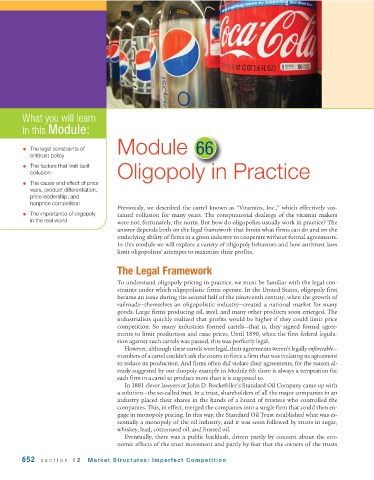Page 694 - Krugmans Economics for AP Text Book_Neat
P. 694
What you will learn
in this Module:
• The legal constraints of Module 66
antitrust policy
• The factors that limit tacit
collusion Oligopoly in Practice
• The cause and effect of price
wars, product differentiation,
price leadership, and
nonprice competition
Previously, we described the cartel known as “Vitamins, Inc.,” which effectively sus-
• The importance of oligopoly tained collusion for many years. The conspiratorial dealings of the vitamin makers
in the real world were not, fortunately, the norm. But how do oligopolies usually work in practice? The
answer depends both on the legal framework that limits what firms can do and on the
underlying ability of firms in a given industry to cooperate without formal agreements.
In this module we will explore a variety of oligopoly behaviors and how antitrust laws
limit oligopolists’ attempts to maximize their profits.
The Legal Framework
To understand oligopoly pricing in practice, we must be familiar with the legal con-
straints under which oligopolistic firms operate. In the United States, oligopoly first
became an issue during the second half of the nineteenth century, when the growth of
railroads—themselves an oligopolistic industry—created a national market for many
goods. Large firms producing oil, steel, and many other products soon emerged. The
industrialists quickly realized that profits would be higher if they could limit price
competition. So many industries formed cartels—that is, they signed formal agree-
ments to limit production and raise prices. Until 1890, when the first federal legisla-
tion against such cartels was passed, this was perfectly legal.
However, although these cartels were legal, their agreements weren’t legally enforceable—
members of a cartel couldn’t ask the courts to force a firm that was violating its agreement
to reduce its production. And firms often did violate their agreements, for the reason al-
ready suggested by our duopoly example in Module 65: there is always a temptation for
each firm in a cartel to produce more than it is supposed to.
In 1881 clever lawyers at John D. Rockefeller’s Standard Oil Company came up with
a solution—the so-called trust. In a trust, shareholders of all the major companies in an
industry placed their shares in the hands of a board of trustees who controlled the
companies. This, in effect, merged the companies into a single firm that could then en-
gage in monopoly pricing. In this way, the Standard Oil Trust established what was es-
sentially a monopoly of the oil industry, and it was soon followed by trusts in sugar,
whiskey, lead, cottonseed oil, and linseed oil.
Eventually, there was a public backlash, driven partly by concern about the eco-
nomic effects of the trust movement and partly by fear that the owners of the trusts
652 section 12 Market Structures: Imperfect Competition

